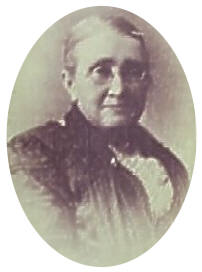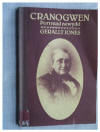
































|
|
|

|
Miss
Sarah Jane Rees ('Cranogwen')
Master Mariner, Music Teacher, Crowned Bard, Preacher, Lecturer and an
active member of The Temperance Union.
1839
- 1916. |
|
A book
'Cranogwen' 'Portread newydd' was written by Gerallt Jones
of Caerwedros in 1980 and published by Gwasg Gomer Llandysul in
1981. The book is out of print.
ISBN
0 85088 664 3
Another
book 'Cofiant Cranogwen', written by Rev. D G Jones of Pontardawe
was published in 1932 and has been out of print for many years. Both of
these books were published in the Welsh Language. |

Click on Picture to
see Full Size |
|

Click on Picture to
see Full Size |
Cranogwen is buried in the grounds of St Caranog Church and her grave is
located to the left of the main entrance at the top edge of the
perimeter.
|
Cranogwen
was Sarah Jane Rees's bardic title and in 1865 she was the first woman to
gain the coveted chair of the Royal National Eisteddfod in Aberystwyth and
in 1873, she won the chair at Aberaeron Chair Eisteddfod. She presented the
chair to Capel Bancyfelin, where it could be seen in the Pulpit.
The book,
The
Story of Llangrannog,
has a chapter dedicated to
Cranogwen. To obtain more
information on where to obtain a copy, please go to the page
New
Book.
Sarah Jane Rees (Cranogwen, 1839-1916).

Cranogwen
Land of
Legends
Remarkable and headstrong poet Sarah
Jane Rees (1839-1916),
better known as Cranogwen, was born in Llangrannog.
She quickly rebelled
against the typical roles expected of a Victorian woman and
instead became a master mariner, the first woman to win major bardic
prizes at the National Eisteddfod, a teacher, music examiner, lecturer,
temperance advocate, editor and preacher. She toured the USA in 1869-1870,
lecturing Welsh immigrant communities. Openly in a lifelong lesbian
relationship, she was passionate about encouraging other women to freely
develop themselves rather than unwittingly fall into marriage, motherhood,
and domestic servitude. Originally a hidden village above the old port,
Llangrannog is now a popular beach destination. Explore the sandy cove and
travel up the narrow valley past the waterfall to St.
Crannog’s, where Cranogwen is buried.

CRANOGWEN (Sarah Jane
Rees 9.01.1839 – 27.06.1916)
Master Mariner; Teacher of
Navigation and local Schoolmistress; Editor, Writer and winner of the 1865
Bardic Crown; Preacher.
Sarah Jane Rees was born near
Llangrannog in 1839, the youngest of a family of 3 children, and the only
girl. Her father, John Rees, a sea captain, and her mother, Frances, both
believed their daughter should be educated as well as their sons. In rural
areas this was difficult as money was scarce, so Sarah Rees’s initial
learning was done in the Chapel Sunday School. Here she learnt to read and
write but meantime her weekdays were taken up playing on the beach,
exploring the boats and rocks, and adventuring further afield in what
became recognised as her ‘very independent manner’.
When she was able to start school
she was hungry for knowledge and read everything she could. Her teacher,
Hugh Davies, encouraged her by giving her access to every book he
possessed. But it was still the era when the needs of her brothers
outweighed hers, and at the age of 13 she was sent to Cardigan, 12 miles
away, to learn dressmaking. She returned home very quickly – she and
needles were incompatible. Instead, Sarah Rees decided to go to sea with
her father.
John Rees captained a ketch
cargo boat which sailed from the port of Llangrannog. His
journeys tended to be short ones – to Liverpool, Swansea or Llanelli, and
occasionally to France and Holland
. To
the utter astonishment of neighbours, he allowed Sarah to accompany him
for the next two years. During this time she mastered the
rudiments of navigation, which she would later teach.
By 1854, when she was 15, her
brothers were able to support themselves, and, again to everyone’s
astonishment, Sarah returned to school. She studied in New Quay, Liverpool
and London, extending her knowledge of Latin and navigation, and qualifying
for her Captain’s certificate which enabled her to sail to any part of the
world.
At the age of 21 (in 1860) she
became schoolmistress at Pontgarreg, where her former teacher Hugh Davies
had ended his career. Here Sarah began to teach navigation to mariners,
enabling them to obtain their certificates. They later became called
“Cranogwen’s Captains”, after Sarah adopted her bardic name in 1865. In
addition to teaching navigation, she also taught the music notation system
“Tonic Sol-fa”.
During the year 1865 Sarah
submitted a lyric poem to the Aberystwyth national eisteddfod, and won the
Bardic crown. Her bardic name “Cranogwen” is a derivative of St. Carannog,
the saint who gave his name to the village of Llangrannog, and whose cell
and church stand in the village. After this, Cranogwen began public
lecturing and preaching, travelling not just around Wales but also to Welsh
communities in America. In addition she started a “Band of Hope”
temperance movement in Bancyfelin Chapel in Llangrannog (now a private home)
and extended this work throughout Wales.
Her concern for the interest of
women led her to found a Welsh Journal devoted to their interests. She not
only edited the paper but wrote much of it herself: travel articles, “agony
aunt” advice, biographies of famous people, all were included, and written
by her. Fashion articles were, however, beneath her!
Eventually Cranogwen gave up this
work to concentrate on her preaching, and on moral welfare in the
industrialised areas of South Wales, establishing the South Wales Women’s
Temperance Union in 1901.
One of her aims in life was to
encourage women to develop themselves at a time when the main routes open to
them were marriage (and motherhood) or domestic service. Her desire to
educate showed itself in the way she taught navigation to mariners, reading
and writing to children, and tonic sol-fah to
would-be musicians. In
addition she was a preacher and had taught in the Sunday School. She was
also a master mariner in her own right.
It
was reported that people did what Cranogwen asked – no-one dared disobey
her. We can safely assume the truth of that – no-one opposed her when she
took her small dog on preaching engagements (e.g. to Chapel)!
Her memorial is at the rear of
St. Carannog’s churchyard (go out of the church and turn right, and right
again immediately, at the top of the churchyard you will find the Rees
family grave).
The Dictionary of Welsh Biography down to
1940 (London, 1959)
Recollections of Cranogwen by J.N. Crowther,
Welsh Gazette, 25/5/27.
Angela John, Our Mother’s Land. Chapters in
Welsh women’s history (Cardiff, 1991)
‘A Woman ahead of her time’ by David W.
James, Country Quest, Feb. 1989.
Anne
Greig 2003.
annegreig@dsl.pipex.com

|







